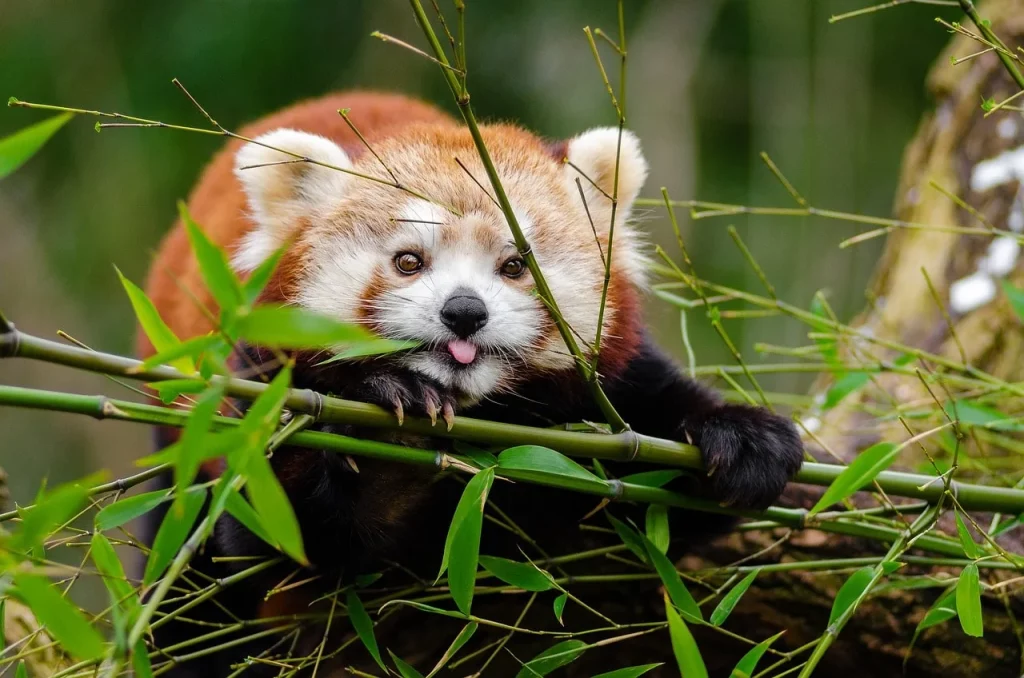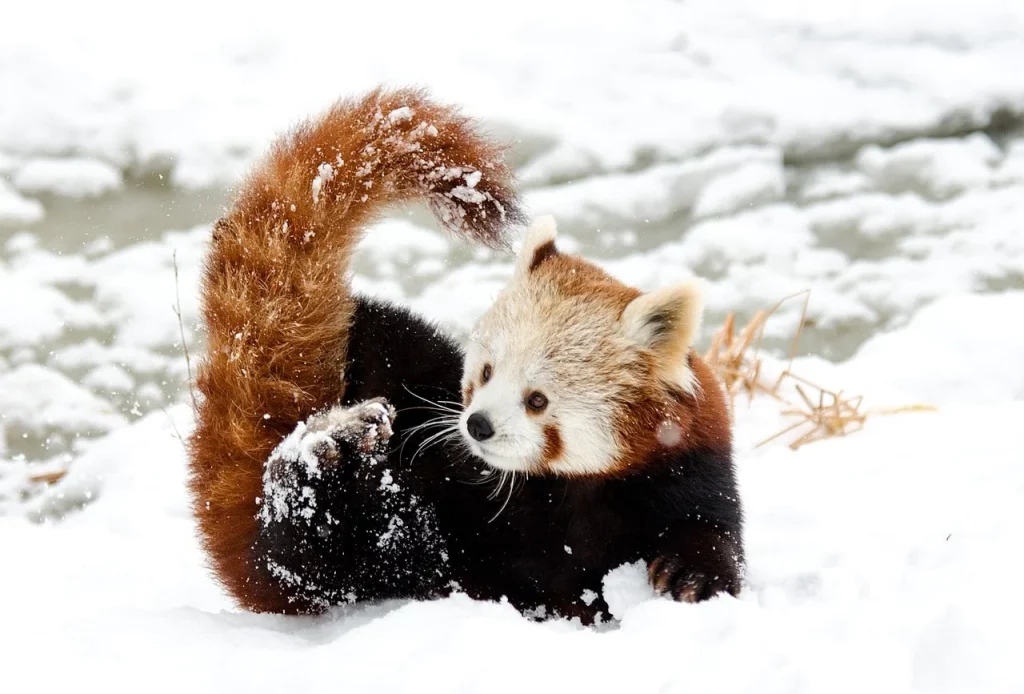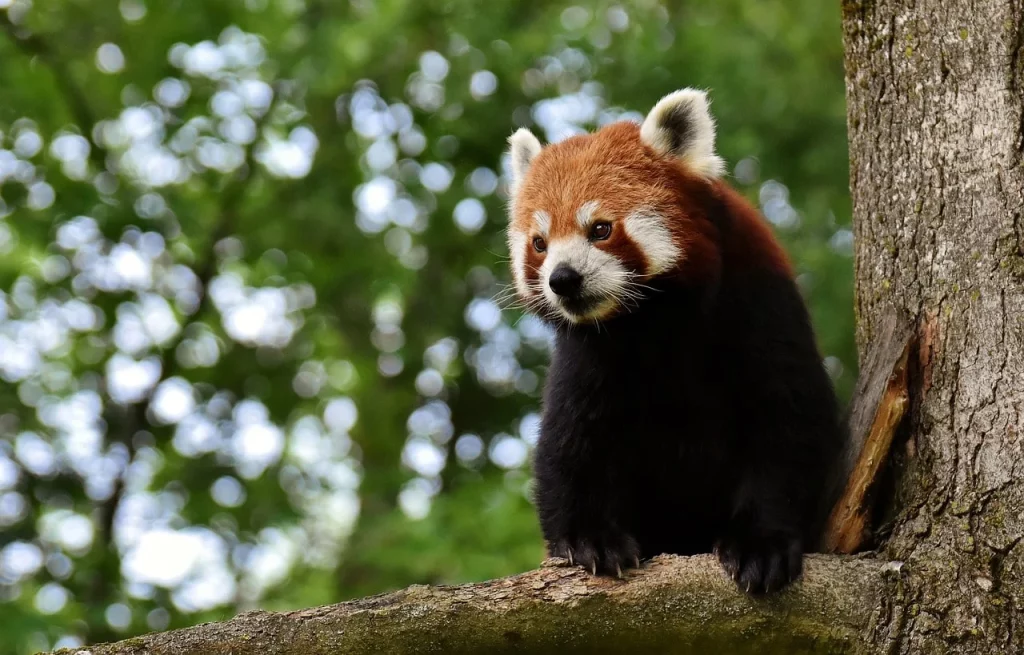In the dense, mist-shrouded forests of Asia, there lurks a creature so endearing that legends say it has the power to melt the coldest of hearts with a single glance. This isn’t your average fairy tale beast; it’s the red panda, an animal so unique it seems to defy the laws of nature.
With a diet that’s 98% bamboo, these critters are the ultimate vegans of the wild, sporting a fiery coat that makes them stand out in their green world. They spend their days lounging in trees, contemplating the mysteries of the universe, or perhaps just figuring out where their next bamboo meal is coming from.
It’s hard not to be enchanted by their quirky charm, and even harder not to chuckle at their clumsy antics. But have you ever wondered what secrets these fuzzy philosophers hold within their tree-top libraries? Let’s find out.
Red pandas, with their gentle demeanor and fiery coats, remind us of nature’s delicate balance.
Unknown
Red Panda Facts
Dive into the interesting facts about red pandas that I gathered for you. And don’t forget, there’s a quiz waiting at the end of this article. Read carefully.
- These creatures are the only living members of their family, Ailuridae.
- They use their ringed tails as blankets to keep warm in the cold mountain air.
- Their diet consists mostly of bamboo, but they also eat fruits, acorns, and eggs.
- Despite their name, they share more genetic similarities with raccoons and weasels than with giant pandas.
- Their reddish-brown fur provides excellent camouflage among the red moss and white lichens of their forest habitat.
- They have a wrist bone that acts like a thumb, helping them grasp bamboo and other foods.
- These animals are most active at dawn and dusk, making them crepuscular.
- Their population is decreasing due to habitat loss, poaching, and the pet trade.
- They communicate with whistles, squeaks, and twitters.
- When threatened, they stand on their hind legs to appear larger.
- Baby red pandas are born with pale fur, which darkens as they grow.
- They can climb down trees headfirst.
- Their scientific name, Ailurus fulgens, means “shining cat.”

- They have a sensitive nose that easily detects their favorite foods.
- Natural predators include snow leopards, martens, and birds of prey.
- They have a false thumb, which is actually an extension of the wrist bone.
- An adult can weigh up to 14 pounds, about the size of a domestic cat.
- Their tails can be as long as their bodies, adding balance and agility.
- They prefer solitary lives and mark their territories with secretions from scent glands.
- Zoos play a critical role in their conservation through breeding programs.
- Females usually give birth to one to four offspring in the spring or summer.
- Their fur is so thick that it’s nearly waterproof.
- They can live up to 14 years in the wild and even longer in captivity.
- They spend most of their time in trees, even when sleeping.
- Their claws are semi-retractable and help grip tree branches and bark.
- In winter, they can reduce their metabolic rate to conserve energy.
- They have a sweet tooth, enjoying the occasional sugary fruit or berry.
- International Red Panda Day is celebrated to raise awareness about their conservation.

- They can swim if needed, although they prefer to stay on land.
- Their gestation period lasts about 134 days.
- They use their tails for balance while navigating through the treetops.
- Interestingly, they were discovered before the giant panda.
- Fossils suggest they have existed for millions of years.
- They have a slow reproduction rate, which challenges conservation efforts.
- Their diet makes them important for the ecosystem, as they help control bamboo forests.
- Red pandas can eat up to 20% of their body weight in bamboo daily.
- They have few natural enemies, but human activities pose significant threats.
- Captive breeding programs have helped increase their numbers.

- They have a “thumb” that’s actually an evolved wrist bone to help grasp bamboo.
- Their solitary nature makes them hard to spot in the wild.
- Deforestation and farming reduce their natural habitat, threatening their survival.
- They are skilled climbers and can descend trees headfirst, like squirrels.
- They prefer temperate forests with dense canopies and undergrowth.
- Their paw pads have fur to provide insulation against cold surfaces.
- They have a territory range that can span up to 2.5 square miles.
- Climate change affects their habitat and food sources, posing a long-term threat.
- They have a unique ability to taste artificial sweeteners, unlike most other animals.
- Their name means “fire fox” in Nepali, referring to their vibrant fur color.
- They use body language, such as head bobbing and tail arching, to communicate.
- Despite their small size, they have a large home range, needing up to 100 acres of forest to thrive.
Red Panda Myths

After reading all these fun facts about red pandas, we continue our journey with some myths. Let’s uncover the actual truth behind the common myths surrounding these creatures.
- Red pandas are just smaller versions of giant pandas
Contrary to popular belief, red pandas and giant pandas share little beyond a name and a bamboo-based diet. Genetically distinct, red pandas are the only living members of their family, Ailuridae, whereas giant pandas belong to the bear family, Ursidae. - Red pandas are found all over Asia
Although it is commonly thought that they inhabit vast regions across Asia, they are actually found only in the temperate forests of the Himalayas, extending from Nepal to China. Their habitat is quite specific and limited to these areas. - Red pandas can easily adapt to life in captivity
In reality, they face significant challenges in captivity, such as specific dietary needs and sensitivity to temperature changes. Efforts are made by zoos to mimic their natural habitat, but the stress of captivity often affects their health and breeding. - Red pandas have no natural predators
This is a misconception. They do have natural predators, including snow leopards and martens. Their reddish-brown fur helps them blend into the canopy of fir trees, offering some protection, but they are not completely safe from predation. - Red pandas are abundant in the wild
Sadly, this is far from the truth. They are classified as endangered, with fewer than 10,000 individuals believed to exist in the wild. Their numbers are declining due to habitat loss, poaching, and the pet trade, making conservation efforts critical for their survival.
No products found.
Red Panda FAQ

We reached the final section before the trivia. Read these questions carefully so you can ace the following quiz.
- Is a Red Panda a Bear?
Nope, they aren’t bears. They’re actually more closely related to raccoons and weasels. They belong to their own unique family called the Ailuridae. So, despite the “panda” in their name, they’re not close relatives of the giant panda. - Can Red Pandas Be Pets?
It’s not a good idea to keep them as pets. They’re wild animals with specific dietary and habitat needs that are difficult to meet in a home setting. Plus, they’re protected under conservation laws to prevent their numbers from declining further. - Are Red Pandas Endangered?
Yes, they are classified as endangered. Their numbers are decreasing due to habitat loss, poaching, and accidental traps. Conservation efforts are in place to help protect these adorable creatures and their habitats. - How Long Do Red Pandas Live?
In the wild, they live for about 8 to 10 years. However, in captivity, with proper care, they can live up to 15 years. Their lifespan is influenced by factors like habitat quality, predation, and disease. - Do Red Pandas Hibernate?
Unlike some of their distant relatives, they do not hibernate. Their thick fur coats and bushy tails help them stay warm through the winter. They might become less active in extreme cold but don’t go into true hibernation.
Red Panda Trivia

Welcome to the ultimate red panda quiz! Brace yourself, because if you don’t get any questions right, a red panda will sneak into your dreams to remind you of their cuteness overload.
Conclusion
Red pandas serve as a reminder of our planet’s incredible biodiversity and the urgent need to protect it. These small mammals face huge challenges, but with continued research and conservation efforts, we have the power to make a difference.
Let’s be inspired by the resilience of red pandas and work towards a future where they can roam freely in their natural habitats. Funny question: If red pandas could talk, what’s the first thing you think they would say to us? Let me know in the comments.
3 Sources Used For This ArticleThe Red Panda Habitat – Birds Facts
Why Are Red Pandas Endangered – Animal Hype


